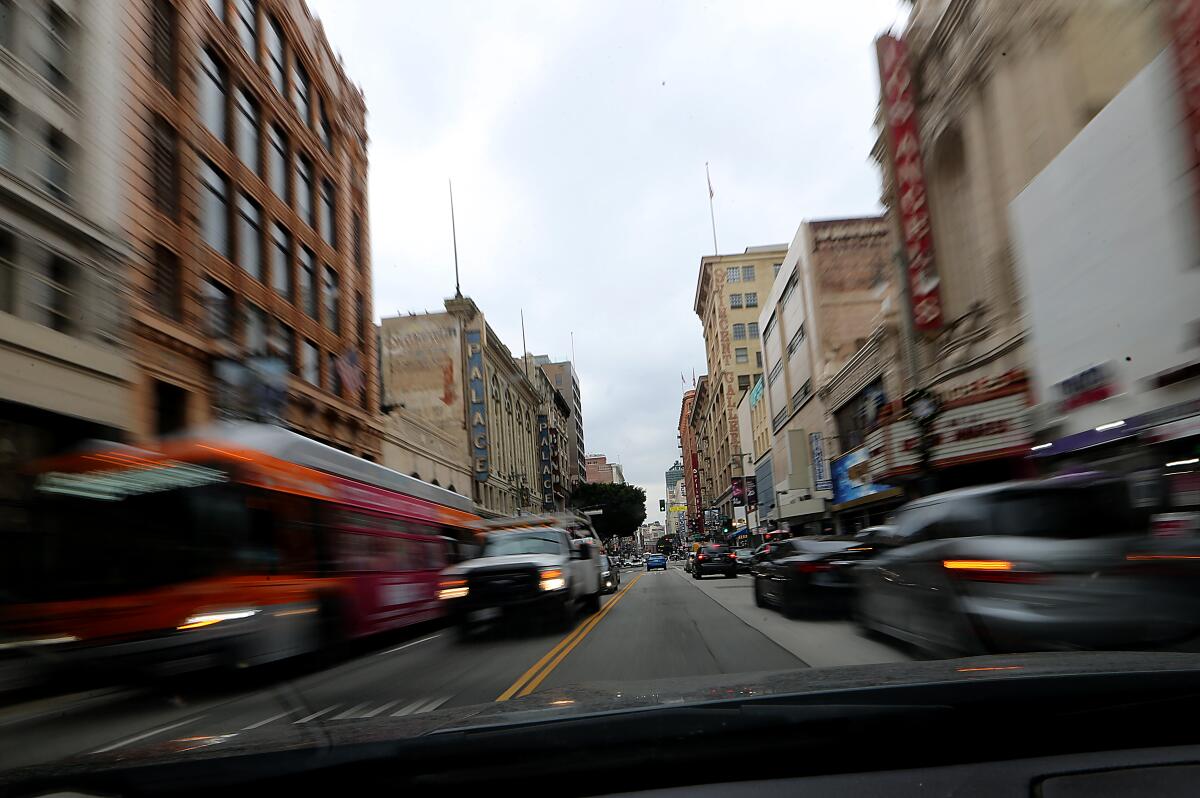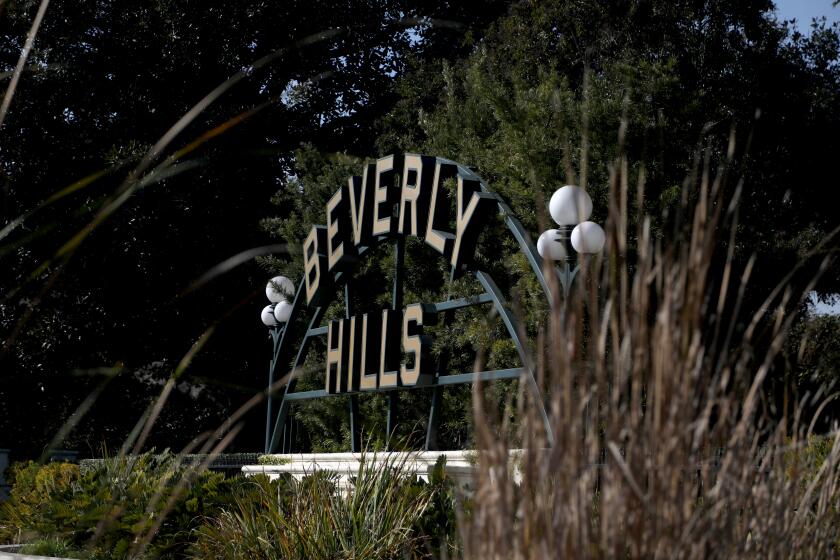Los Angeles’ building earthquake retrofit data have been outdated for years, Times investigation uncovers

- Share via
For nearly a decade, Los Angeles has touted its sweeping earthquake safety ordinance — the nation’s toughest, which requires thousands of buildings to be evaluated and strengthened if necessary.
But city officials never made it easy for Angelenos to look up retrofit information about their building.
In 2023, The Times asked for the city’s lists of non-ductile concrete and soft-story buildings, as well as their retrofit statuses. After publishing a map that allowed Los Angeles residents to review the earthquake risk of their building, The Times was contacted by several property owners who said the data the city provided indicated their buildings were not retrofitted, when in fact they were.
The misinformation caused concern among property owners that lost out on leases with prospective tenants who thought seismic retrofits had not been completed on their buildings. Several residents expressed fear for their family’s safety living in an unretrofitted building.
Once The Times became aware of the errors, editors added a note to readers on the article and reporters began sifting through permit records and making inquiries to the city. The full scope of the problems did not become clear until 18 months later.
On a July 25 video call, officials walked Times reporters through the errors and acknowledged that, for years, the Department of Building and Safety had been incorrectly reporting which buildings have been retrofitted and which have not.
The magnitude 5.2 earthquake near Bakersfield was felt over a wide area of Southern California. Experts say there are several reason for this, including its size, time of night and the so-called ‘basin effect.’
“The retrofitting database system relies heavily on manual input and manual adjustments of the reports, which while sufficient for individual enforcement purposes, has not been able to produce program-wide reports to the standards that we desire,” Gail Gaddi, public information director of the Los Angeles Department of Building and Safety, said in a statement. “We take this very seriously and will take the necessary steps to automate the reporting system to ensure all the reports are accurate.”
As a result of The Times’ inquiries, Los Angeles Mayor Karen Bass asked the department to establish a task force to review records, automate its manual data work and hire an independent auditor.
“Angelenos deserve to know the status of retrofits for buildings they live in, own, or are considering living in,” Clara Karger, a spokesperson for Bass, said in an email.
The guide to earthquake readiness and resilience that you’ll actually use.
The Times’ questions also prompted the city in February to stop issuing monthly seismic progress reports.
Since the ordinance went into effect nine years ago, the city had been publishing reports detailing the number of buildings in compliance, those that have started work and those that have submitted plans. The mayor’s office has touted the program by referring to these reports, which also are used by trade groups such as the Structural Engineers Assn. of Southern California, to hold city officials accountable for their work on retrofits.
The Times’ questions about the city’s records began even before publishing the map. But what initially appeared to be one-off flaws in the data — including listing Los Angeles City Hall as having not been retrofitted when, in fact, its seismic upgrade was completed in 2001— were actually signs of inaccurate data handling.
Times reporters spent months reviewing more than 1,000 city permits, talking to multiple building owners and tenants to understand the discrepancies and inquiring about incorrect data from the city.
On Jan. 16, in response to inquiries about specific buildings — including several large Broadway Theater District commercial buildings incorrectly labeled as not retrofitted — officials said in an email: “[The department] is confident that our retrofit data is correct. We will look closely into the addresses that LA Times has provided.”
By then, The Times had identified at least 56 buildings, both soft-story and non-ductile concrete, that were incorrectly categorized. One example: A retrofit was performed in 2021 for a large commercial building on Broadway, but city records showed it was incomplete.
After further questions the following month, building officials acknowledged in an email a mismatch in the data. For the list of non-ductile concrete and soft-story buildings, “the data within the exported spreadsheet did not entirely align with our internal databases.”
The primary cause of the errors, officials later admitted, was the fact that the city failed to accurately combine two databases — one of building permits and another of addresses. The city’s database mistakenly linked irrelevant permit information to the list of buildings requiring a seismic update. This resulted in the incorrect labeling of many buildings.
“We realized from the IT side that there would have been this potential for multiple permits that were issued that would reflect the work for one building,” Minh Ong, a civil engineer with the Department of Building and Safety said. “We know the associations are incorrect on them and have to walk through the data one building at a time.”
The Times’ map originally included 73 retrofitted non-ductile concrete buildings in Los Angeles. In the months since the errors were uncovered, the Department of Building and Safety gave different totals: In January, it said 73 concrete buildings were retrofitted; in April, 91; and in mid-July, 127. In the final list sent on July 25, the agency said the number was 101.
However, a Times analysis of the city’s newest data shows that at least four buildings were categorized as not retrofitted when they had already been strengthened, according to city permits.
The Times has obtained a list of soft-story buildings requiring a seismic retrofit in Beverly Hills.
To date, officials have updated the retrofit information for at least 10 non-ductile concrete buildings based on evidence provided by The Times. Two architecture and engineering firms confirmed to a reporter that the building department had called to verify records based on what The Times’ reading of permits showed.
The status of the city’s soft-story buildings, which are mostly apartments, remains unclear.
After the July video call, city officials said they would share corrected soft-story records the next day. Two days later, the department instead said it would overhaul its database and hire an auditor. The Times has removed the city’s data from its map.
The mayor’s office acknowledged the process of correcting the building department’s records could take months. There are 12,347 soft-story buildings and 1,194 concrete buildings in Los Angeles, according to the city’s data.
Meanwhile, residents still want to know how they can check the retrofit status of their homes and workplaces.
Emily Guiltinan was looking to move and came across The Times’ map when researching earthquake safety.
“I was like, wow, that’s disturbing. How safe are the buildings we live in?” she said. “Basically, the answer was not very.”
Guiltinan tried to use the city’s permit portal to look up buildings and was unable to find complete records for prospective buildings in her neighborhood. When she called the department’s hotline she said a representative told her “not to worry about earthquakes” because they happen “once in a blue moon and aren’t that big of a deal.”
While Guiltinan was speaking with The Times in a phone interview, a magnitude 4.9 earthquake centered in the Mojave Desert was felt in Los Angeles.
More to Read
Sign up for This Evening's Big Stories
Catch up on the day with the 7 biggest L.A. Times stories in your inbox every weekday evening.
You may occasionally receive promotional content from the Los Angeles Times.














